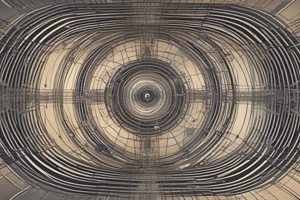Podcast
Questions and Answers
What does the center of mass (COM) represent in a body?
What does the center of mass (COM) represent in a body?
- The average position of the mass distribution within a body (correct)
- The point where gravitational force acts
- The point of maximum mass concentration
- The location of the body's centroid only
How is the center of mass calculated for a system of discrete particles?
How is the center of mass calculated for a system of discrete particles?
- By averaging the positions of all particles irrespective of their mass
- By summing all masses and dividing by the number of particles
- By determining the geometric center of the mass distribution
- By using the weighted average of the particle positions based on their mass (correct)
What is true about the center of mass of a rigid body under normal conditions?
What is true about the center of mass of a rigid body under normal conditions?
- It is affected only by the object's shape.
- It remains constant if the body is not deforming. (correct)
- It moves in the opposite direction of external forces.
- It changes location with time.
Why is understanding the center of mass important for determining system stability?
Why is understanding the center of mass important for determining system stability?
Which of the following correctly states the effect of gravitational force on an object?
Which of the following correctly states the effect of gravitational force on an object?
For a uniform rod, where is the center of mass located?
For a uniform rod, where is the center of mass located?
In what way does the concept of center of mass extend to engineering applications?
In what way does the concept of center of mass extend to engineering applications?
How does the motion of a body relate to its center of mass?
How does the motion of a body relate to its center of mass?
Flashcards
Center of Mass (COM)
Center of Mass (COM)
The point representing the average position of a body's mass distribution. It determines the body's translational motion.
What is the COM?
What is the COM?
The weighted average position of all the constituent parts of a body.
How to calculate COM for discrete masses?
How to calculate COM for discrete masses?
For a system of discrete masses, the COM's coordinates are calculated as a weighted average of the positions of each mass.
COM and External Forces
COM and External Forces
Signup and view all the flashcards
COM and Gravity
COM and Gravity
Signup and view all the flashcards
COM and Stability
COM and Stability
Signup and view all the flashcards
Importance of COM in motion prediction
Importance of COM in motion prediction
Signup and view all the flashcards
Applications of COM
Applications of COM
Signup and view all the flashcards
Study Notes
Definition
- The center of mass (COM) of a body is a point where the weighted average position of all the constituent parts of the body is located.
- It represents the average position of the mass distribution within a body.
- The COM coincides with the centroid for bodies of uniform density.
- This point is crucial for analyzing the translational motion of the body as a whole.
Calculating Centre of Mass
- For a system of discrete particles, the coordinates of the COM are determined by the weighted average of the particle positions.
- If a body has discrete masses
m₁,m₂, ...,mₙat positions(x₁, y₁),(x₂, y₂)....,(xₙ, yₙ), then the COM is located at: x_com = (m₁x₁ + m₂x₂ + ... + mₙxₙ) / (m₁ + m₂ + ... + mₙ)y_com = (m₁y₁ + m₂y₂ + ... + mₙyₙ) / (m₁ + m₂ + ... + mₙ)- When continuous mass distributions are involved, the equivalent formulation but involving integrals is used.
Characteristics
- The center of mass of a rigid body doesn't change with time or external forces, if the body is not deforming.
- The gravitational force acts on the centre of mass of an object, effectively making the COM the point where the weight of the object acts.
- The motion of the entire body is determined using the properties of the COM. For example, constant linear acceleration and velocity.
- For an object rotating about a fixed axis, the force about the axis influences the rotation (rotational motion), while the force acting along the line of the axis affects the translation motion of the COM.
Significance
- Prediction of motion — crucial for predicting how a system will move under a variety of forces, especially gravity.
- Stability — Understanding the COM is vital for determining the stability of a system. The lower the COM, the more stable the object.
- Complex systems analysis — The concept of the COM extends to more complex systems like rigid bodies and continuous distributions of mass.
- Engineering Applications — plays a critical role in engineering design, from designing bridges to aircraft, where stability and motion are paramount.
Examples
- A uniform rod — the center of mass is at the geometrical center.
- A composite body — the center of mass is found by calculating the weighted average positions of the component parts.
- A human body standing — the center of mass is located somewhere around the lower back or hip region.
- Calculating the center of mass of a system of particles — The above equations can be used.
Studying That Suits You
Use AI to generate personalized quizzes and flashcards to suit your learning preferences.




